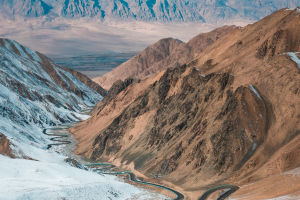Around 40 million years ago, a warm-blooded mammal the size of today's rabbits, known as the llama, emerged in North America and is considered the ancestor of today's camels.
Approximately 3 million years ago, during the early Pleistocene period, the Isthmus of Panama formed, allowing camels to migrate from North America to South America.
In the Andes region of South America, the descendants of llamas, including llamas, alpacas, guanacos, and vicuñas, thrived and multiplied. Meanwhile, about 500,000 years ago, the modern camel as we know it today emerged in North America.
The earliest Asian camels were the Bactrian camels, while in the hotter regions of Arabia and African deserts, camels evolved into the dromedary form, which is more common today. This adaptation reduced the camel's body surface area, thereby minimizing water evaporation.
Camels possess unique characteristics that make them one of the few animals that can be domesticated. They are easily herded, gentle, and lack the fear of humans. Additionally, they exhibit resistance to human diseases, and most importantly, they can reproduce continuously in captivity.
For thousands of years, camels have provided humans with sustenance in the form of meat and milk. Compared to milk from other ruminants, camel milk contains lower cholesterol levels and higher amounts of vitamin C, sodium, and potassium.
Camel milk is also considered more akin to human milk than cow's milk. In arid desert regions where camels reside, their meat serves as a vital source of protein.
In the vast expanse of the desert, where sand and wind dominate the landscape, camels play an indispensable role in the lives of desert dwellers. They were domesticated centuries ago and have since served as invaluable companions for humans.
Camels are vital for traversing the extreme water scarcity and scorching heat of the desert, covering distances of over 30 kilometers per day.
Throughout ancient and modern times, camels have been employed as reliable means of transportation for long journeys across desert regions. Their ability to endure drought and extreme heat makes them ideal for such purposes.
Bactrian camels, capable of carrying up to 200kg, and dromedaries, capable of carrying up to 100kg, provide the means for people to travel long distances. With just one rider, a camel can easily cover 100 kilometers in a day, traveling at speeds of approximately 9-12 kilometers per hour.
Moreover, camels possess physical adaptations that suit them for desert life. Their long, curved necks and hoofed feet enable them to navigate and climb desert dunes. Camels can close their mouths and nostrils to prevent sand and dust from infiltrating, and they possess the ability to tolerate high temperatures and arid climates.
Camels also possess a remarkable ability to manage water. They can store large quantities of water within their bodies, enabling them to survive without a water source for extended periods.
Their blood composition aids in regulating body temperature, keeping them cool in the heat and warm during cold desert nights. Additionally, camel dung can be used as fuel or building material.
In the modern world, camels have also become a popular attraction for tourists seeking to experience the thrill of riding across desert dunes. Camel rides offer a unique way to immerse oneself in the excitement and ambiance of the desert. Furthermore, camel racing and camel shows have gained popularity as entertaining spectacles.
Overall, camels have played a significant role in human history, providing sustenance, transportation, and entertainment. Their unique adaptations and abilities make them well-suited for desert life and continue to capture the fascination of people worldwide.


